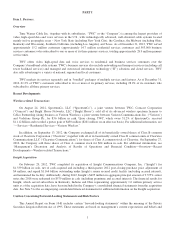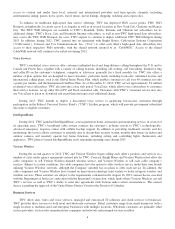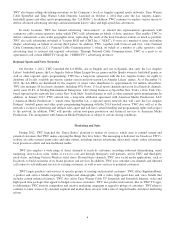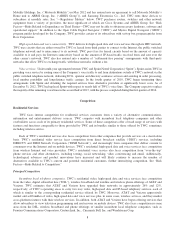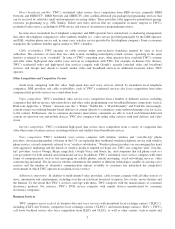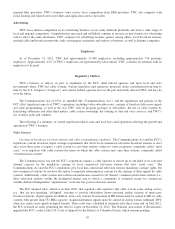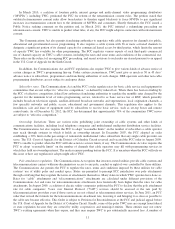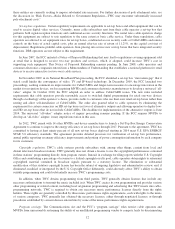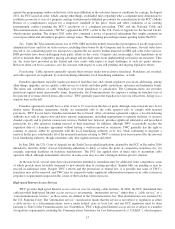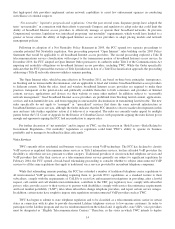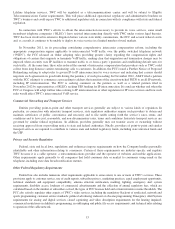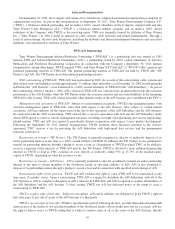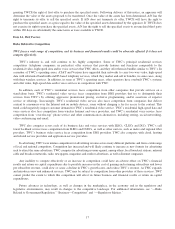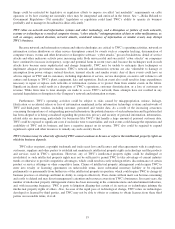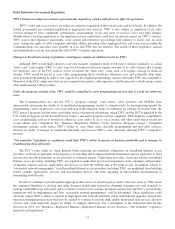Time Warner Cable 2012 Annual Report Download - page 21
Download and view the complete annual report
Please find page 21 of the 2012 Time Warner Cable annual report below. You can navigate through the pages in the report by either clicking on the pages listed below, or by using the keyword search tool below to find specific information within the annual report.In March 2010, a coalition of fourteen public interest groups and multi-channel video programming distributors
(“MVPDs”), including TWC, petitioned the FCC for reform of the retransmission consent rules. The petition stated that
outdated retransmission consent rules allow broadcasters to threaten signal blackouts to force MVPDs to pay significant
increases in retransmission consent fees to the detriment of MVPDs and consumers. Shortly thereafter, the FCC issued a
Public Notice seeking comment on the petition and, in March 2011, the FCC initiated a rulemaking proceeding on
retransmission consent. TWC is unable to predict what rules, if any, the FCC might adopt in connection with retransmission
consent.
The Communications Act also permits franchising authorities to negotiate with cable operators for channels for public,
educational and governmental access programming. It also requires a cable system with 36 or more activated channels to
designate a significant portion of its channel capacity for commercial leased access by third parties, which limits the amount
of capacity TWC has available for other programming. The FCC regulates various aspects of such third-party commercial
use of channel capacity on TWC’s cable systems, including the rates and some terms and conditions of the commercial use.
These rules are the subject of an ongoing FCC proceeding, and recent revisions to such rules are stayed pursuant to an appeal
in the U.S. Court of Appeals for the Sixth Circuit.
In addition, the Communications Act and FCC regulations also require TWC to give various kinds of advance notice of
certain changes in TWC’s programming line-up. Under certain circumstances, TWC must give as much as 30 or 45 days’
advance notice to subscribers, programmers and franchising authorities of such changes. DBS operators and other non-cable
programming distributors are not subject to analogous duties.
Subscriber rates. The Communications Act and the FCC’s rules regulate rates for basic cable service and equipment in
communities that are not subject to “effective competition,” as defined by federal law. Where there has been no finding by
the FCC of effective competition, federal law authorizes franchising authorities to regulate the monthly rates charged by the
operator for the minimum level of video programming service, referred to as basic service tier or BST, which generally
includes broadcast television signals, satellite-delivered broadcast networks and superstations, local origination channels, a
few specialty networks and public access, educational and government channels. This regulation also applies to the
installation, sale and lease of equipment used by subscribers to receive basic service, such as set-top boxes and remote
control units. As of December 31, 2012, the FCC has determined that approximately 70% of the communities TWC serves
are subject to “effective competition.”
Ownership limitations. There are various rules prohibiting joint ownership of cable systems and other kinds of
communications facilities, including local telephone companies and multichannel multipoint distribution service facilities.
The Communications Act also requires the FCC to adopt “reasonable limits” on the number of subscribers a cable operator
may reach through systems in which it holds an ownership interest. In December 2007, the FCC adopted an order
establishing a 30% limit on the percentage of nationwide multichannel video subscribers that any single cable provider can
serve. The U.S. Court of Appeals for the District of Columbia Circuit reversed and vacated the FCC order in August 2009.
TWC is unable to predict when the FCC will take action to set new limits, if any. The Communications Act also requires the
FCC to adopt “reasonable limits” on the number of channels that cable operators may fill with programming services in
which they hold an ownership interest. The matter remains pending before the FCC. It is uncertain when the FCC will rule on
this issue or how any regulation it adopts might affect TWC.
Pole attachment regulation. The Communications Act requires that investor-owned utilities provide cable systems and
telecommunications carriers with non-discriminatory access to any pole, conduit or right-of-way controlled by those utilities.
The Communications Act permits the FCC to regulate the rates, terms and conditions imposed by these utilities for cable
systems’ use of utility poles and conduit space. States are permitted to preempt FCC jurisdiction over pole attachments
through certifying that they regulate the terms of attachments themselves. Many states in which TWC operates have done so.
Rates for “cable” attachments and “telecommunications” attachments are calculated under different provisions of the
Communications Act and rates for telecommunications attachments have historically been higher than the rates for cable
attachments. In August 2009, a coalition of electric utility companies petitioned the FCC to declare that the pole attachment
rate for cable companies’ Voice over Internal Protocol (“VoIP”) services should be assessed at the rate paid by
telecommunications providers even if those services are not offered as telecommunications services. In June 2011, an FCC
order that revised the formula for the telecommunications attachment rate, lowering it and bringing it as close as possible to
the cable rate became effective. This Order is subject to Petitions for Reconsideration at the FCC and judicial appeal before
the U.S. Court of Appeals for the District of Columbia Circuit. Finally, some of the poles TWC uses are exempt from federal
or state regulation because they are owned by utility cooperatives and municipal entities. These entities may not renew
TWC’s existing agreements when they expire, and they may require TWC to pay substantially increased fees. A number of
11


